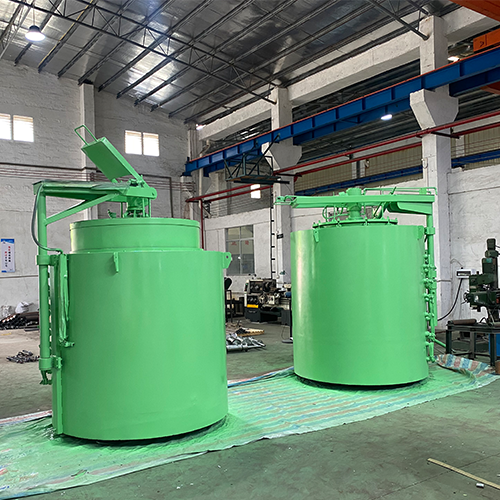Why choose pit type heat treatment furnace
Aug. 28, 2025
The selection of pit-type heat treatment furnaces is primarily based on their vertical structure, which delivers uniform heating, precise temperature control, versatility, energy efficiency, high flexibility, and environmental compliance. These attributes make them particularly suitable for heat-treating long shafts, rods, and components requiring stringent deformation control, as detailed below:
1. Uniform Heating, Reduced Deformation
Vertical Structure Advantage: The cylindrical deep-pit design allows workpieces to be loaded vertically via specialized cranes, ensuring heat penetration from all sides. This eliminates bending deformation caused by gravity in horizontal placement, making it ideal for long shafts and rods (e.g., turbine main shafts, marine propeller shafts).
Temperature Uniformity: Equipped with large-scale ventilators or multi-zone temperature control systems, the furnace minimizes internal temperature differentials (typically ≤ ±5°C), ensuring consistent performance across the workpiece.
2. Precise Temperature Control, Process Reliability
PID Automatic Temperature Control: High-precision sensors and instruments dynamically adjust temperatures with an accuracy of ±1°C, meeting stringent requirements for quenching, tempering, normalizing, and other processes.
Programmable Heating/Cooling Curves: Preset process parameters enable stable batch production while reducing human operational errors.
3. Versatility, Meeting Diverse Needs
Broad Process Coverage: Capable of performing quenching, tempering, normalizing, annealing, carburizing, nitriding, and other heat treatments to enhance performance for various materials (e.g., alloy steel, high-speed steel).
Flexible Atmosphere Control: Controllable atmospheres (e.g., CO, H₂) are introduced via methanol cracking furnaces or other devices to achieve bright heat treatment, preventing surface oxidation and decarburization.
4. Energy Efficiency, Cost Reduction
Optimized Structure: Partial or full underground embedding reduces factory height requirements, while efficient heating elements and insulation minimize heat loss. Electricity consumption for heating a ton of forging to 1100°C is <360 kWh, saving 20%-50% compared to traditional coal furnaces.
Automated Workflow: CNC systems automate heating, cooling, loading, and unloading, cutting labor intervention and boosting productivity by over 30%.
5. Flexible Adaptation, User-Friendly Operation
Workpiece Compatibility: With furnace chamber diameters ranging from 0.5–4.5 meters and depths exceeding 30 meters, the furnace handles everything from slender rods to oversized components (e.g., marine gears, oil pipelines).
Operational Ease: Vertical loading enables high-capacity, low-labor-intensity operations, while bottom-mounted stirring fans enhance convection, shortening heating times and accelerating production cycles.
6. Environmental and Safety Compliance
Clean Heating: Electric or clean fuels (e.g., gas, fuel oil) eliminate smoke emissions from traditional coal furnaces, meeting environmental standards.
Safety Features: Limit switches, seal detection systems, and emergency stop mechanisms ensure safe operation, while superior furnace sealing prevents hazardous gas leaks.
7. Typical Application Scenarios Validating Advantages
Gear Quenching: Cylindrical and bevel gears undergo tooth surface or full-body quenching with deformation <0.05 mm, meeting high-precision transmission demands.
Shaft Component Treatment: Segmented quenching of drive shafts and crankshafts achieves surface hardness of HRC55-60, extending service life.
Oversized Workpiece Processing: Marine gears and large pipelines undergo full or localized quenching, resolving uneven heating issues in conventional methods.
Mold Surface Strengthening: Controlled inductor motion enables localized surface quenching of molds, reducing finishing allowances post-heat treatment.










